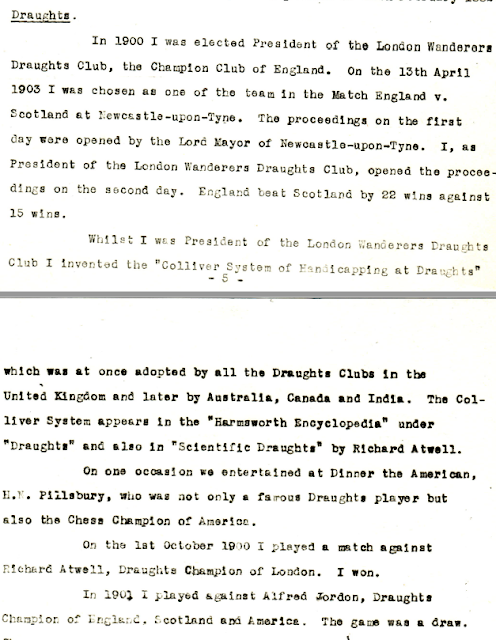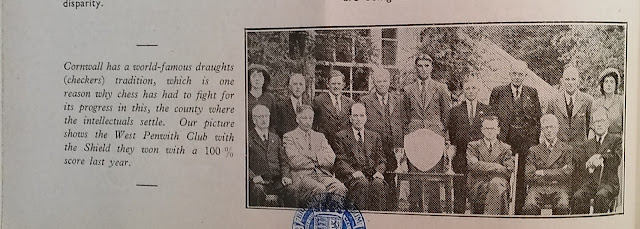The 1950s photograph of the "West Penwith Club" draughts team which instigated this excursion (here it is again, from Chess November 1950)...
...will now start us on the return leg. However, in best Magical Mystery Tour tradition we have a...mystery: the appellation given by Chess. "The West Penwith Club". Who were they?
The Club doesn't come up anywhere in John Gillbard's History of Draughts in Cornwall, and although 1950 was before John's own engagement in the competitive game, he (the expert in the matter) has never heard of said outfit (per private correspondence). Moreover, although John has a collection of Cornish Draughts Trophies (many from defunct competitions) he doesn't recognize the shield depicted, either.
Nor was John able to identify the players in the photo (not altogether surprising as John was only a young lad in 1950), save one: Eddie Varker (extreme left of first row seated). Eddie was - says John - the "mainspring" of draughts in the Penzance area, and instituted the "Varker Shield" which was contested in the annual Cornwall v Devon matches of the 60s and 70s (History p 34); he came from St.Hilary, five miles east of Penzance, whose church was decorated by Joan Manning-Sanders (see the outward episode) - and other local artists - in the 1920s.
Mention of the village of St. Hilary - which had its own 5-strong draughts team in the 50s and 60s - provides the pretext to note other local teams active at some time or another from the 1930s onwards. All of the following won the Cornish Draughts League (many more than once): Ruddlemoor (near St.Austell, the earliest recorded in 1935), Redruth (2 clubs), St. Austell YMCA, Summercourt (Newquay way), Penzance, Liskeard (the last recorded in 1996), Wadebridge, Launceston, and Camborne. You can add also-rans Wendron, Manaccan, Roseland, and Par. Pretty impressive - see map below. Camborne, which was captained John Gillbard himself, won the competition ten times.
| Here there be draughts |
In 1903 the Royal Cornwall Gazette carried a fulsome "biographical sketch" of Mr Colliver - by then 40 and already something of a minor celeb, in St. Columb anyway (the sketch may be found at Appendix 1 below). Before we get on to his draughts, here is a brief summary of the salient features of his energetic life, drawing on the Gazette, and on a sensational autobiographical document "Family History and Reminscences" (henceforth FHR) that Colliver himself had dictated in 1945. This was kindly shared by the family, who have authorised the publication of the extracts below.
Carus Colliver came from farming stock in St.Columb Major, but left for London in 1883, where he began the pursuit of a long and successful career in accountancy; advising - among others - the Dutch millionaire Frederick Cornelius Stoop (who made his money with Royal Dutch Shell, and was a benefactor of the village of Byfleet in Surrey - read about his colourful chess-playing grandson Michael Stoop here). In WW1 Colliver was appointed "Editor of the Secret Cyphers" at the Admiralty because they "wanted a man who never makes a mistake" (FHR p3). In 1882 (when still in St. Columb) he had taken part in the annual Shrove Tuesday "Hurling with the Silver Ball" event, successfully "carrying off the Silver Ball for the Townsmen" (FHR p5) - with all that entails by way of celebration (toasting, climbing lamp-posts, etc). Colliver was to give a radio broadcast for the BBC on the Hurling Match of 1936 (repeated in 1938 - see here at 8.00 pm). The 1968 event was captured for posterity here in grainy black and white.
In FHR Colliver mentions his achievements in bowls, where he played for England v Scotland in 1929 and 1932; and indoor bowling where he won his Indoor Bowling Club championship in 1936. Carus's own list of non-board sports stops here - but it seems he undersold himself. The paragraph below, extracted from the Royal Cornwall Gazette's account of him in 1903 (it appears to recycle a piece from the Draughts World), adds yet more.
Phew! And better not overlook his - or that of someone with the same singular name - offer (advertised in the press) to cure your writer's cramp (1919), and to improve your speed writing (The Times Jan 30 1920). Both services were promoted from 181, Victoria Street, by someone styling themselves now Carus Collver, and then "Prof. Colliver". And yet we have still to get on to his draughts - and his chess; because, yes, Carus played as good a game on 64 squares as he played on 32.
His prowess at draughts first. Here is his own account of his exploits as dictated in 1945 to his niece Pauline Colliver.
 |
| From Family History and Reminiscences (1945) by Carus Colliver (1862-1954) |
So, not too long after emigrating to London in 1883, Colliver was active on the draughts scene. The London Wanderers Draughts Club was formed in 1888, and he was President in 1900 (an honour also reported in the Royal Cornwall Gazette 21 November 1901). However, as for the 1903 England v Scotland encounter: although he may have been "chosen as one of the team", as he put it, according to contemporaneous newspaper accounts he didn't actually play on any of the three days of the match. Nonetheless, he certainly was there as a visitor (Sporting Life 19 April 1903), and did indeed open the second day's play (Norwich Mercury 15 April 1903) as he states.
His "Colliver System of Handicapping at Draughts" enables a tournament to be completed in one evening. Interested readers will find the details in the Appendix extracted from Vocabulary of Checkers by William Timothy Call (New York 1909). The System also appears, says Colliver, in Atwell's Scientific Draughts (1905) - and, as he points out, he defeated Atwell (sometime London Champion) in a match.
 |
| Richard Atwell (1874-1909) From here and Draughts World |
And to top it all, Colliver says he entertained Harry Pillsbury at dinner - though he doesn't report actually playing him at draughts (nor chess come to that), and neither does he give the date. Pillsbury died in 1906 at the age of only 33; he had won the 1895 Hastings Chess Tournament - "the most important tournament of the C19th" (Kasparov) - ahead of Chigorin, Lasker, Tarrasch, and Steinitz, the cream of world chess - and Blackburne, Mason, Burn, Gunsberg, Bird and Tinsley, to add the cream of English. He finished on 16.5/22 (+15; =3; -3).
 |
| As he appears in the book of the 1895 Hastings Chess Tournament. |
Pillsbury was good value at simuls, mixing chess, draughts and, for good measure, whist. The press of the day was full of accounts of his displays, including "his wonderful feat" at the Ladies Club in May 1899 (The Daily Telegraph May 30 1899) when he won all eight games of chess, two at draughts, and two of whist (though he lost another two). Of particular interest is a valedictory appreciation of Pillsbury (London Daily News 27 June 1906, reproduced below) by the above-mentioned Richard Atwell (they played a match in 1900: +4; =? -2 to Pillsbury (result in Manchester Times 24 August 1900). Note the (non committal) comment by Pillsbury on the relative merits of the two games, and seeing 40 (!) moves ahead in one position to save a game. Interestingly we get a complete game score - with diagrams - and I have added one more as an aide to visualisation.
So, again, one thing leads to another, and we have allowed our attention to wander from the straight and narrow, but that's what happens when you are out a-strolling. We will get back to Carus and chess next time.
Acknowledgements.
Particular thanks to Nigel Guess, who is the son-in-law of Carus Colliver's niece (to whom he dictated his reminiscences in 1945), and other family members for their willing and helpful permission to reproduce the document.
John Gillbard (2015). The History of Draughts in Cornwall.
Previous excursions:
Streatham Strolls 1; Streatham Strolls 2; Streatham Strolls 3; Streatham Strolls In The Country; Streatham Strolls In The Country Continued; Streatham Strolls East; Streatham Strolls to Canada. Streatham Strolls West: Outward; Streatham Strolls West: Backtrack; and stroll Home Again! for the final stage West.
Appendix 1
Biographical Sketch of Carus Colliver.
Royal Cornwall Gazette 3 September 1903, page 6
Appendix 2
The Colliver System of handicapping at Draughts
From: Vocabulary of Checkers by William Timothy Call (New York 1909)
Appendix 3
Some checkers games by H.N. Pillsbury - from a thread on the American Checkers Forum here
[Event "Hester's Defiance, p.102, v.333"]
[Date "1903"]
[Black "Pillsbury,HN."]
[White "Grover, S."]
[Result "1/2-1/2"]
11-15 23-19 9-14 27-23 8-11 22-18 15x22 25x9 5x14 29-25 11-15 25-22 4-8 22-17 15-18 32-27 18-22 19-15 10x19 17x10 6x15 23x16 12x19 26x17 8-11 30-26 1-5 17-14 2-6 24-20 6-9 14-10 7x14 27-23 15-18 23x7 3x10 20-16 18-22 26x17 9-13 16-11 13x22 11-8 10-15 8-3 14-18 3-7 22-26 1/2-1/2
[Event "Duffy's Single Corner, v.87"]
[Black "Pillsbury,HN."]
[White "McIntee,J."]
[Result "1/2-1/2"]
11-15 22-18 15x22 25x18 12-16 29-25 10-14 24-19 16-20 28-24 6-10 19-16 1-6 25-22 8-12 22-17 12x28 18-15 10x19 17x1 19-24 1-6 9-13 6-1 4-8 26-22 8-11 23-19 7-10 22-18 3-7 19-16 10-14 18x9 5x14 1-5 14-18 16-12 18-22 12-8 7-10 5-9 11-15 8-3 22-25 3-8 15-18 8-11 25-29 11-16 29-25 16-19 18-22 19-16 25-29 9-14 10x17 21x14 13-17 14-9 17-21 16-19 21-25 30x21 22-26 31x22 24x31 19-23 2-7 9-6 29-25 22-18 7-10 21-17 31-27 6-2 10-15 18x11 27x18 17-13 20-24 1/2-1/2
[Event "Kear's Ency., p.346, v.25"]
[Black "Strudwick,J."]
[White "Pillsbury,HN."]
[Result "1/2-1/2"]
9-14 22-18 5-9 24-19 11-15 18x11 8x24 28x19 4-8 27-24 8-11 24-20 9-13 25-22 11-15 19-16 12x19 23x16 15-18 22x15 10x19 16-11 7x16 20x11 6-10 29-25 10-15 31-27 1-6 25-22 6-10 32-28 14-18 11-7 2x11 26-23 18x25 23x7 13-17 1/2-1/2
[Event "Denvir's Traps and Shots #15"]
[Black "anonymous"]
[White "Pillsbury,HN"]
[Result "0-1"]
11-15 23-19 9-14 27-23 8-11 22-18 15x22 25x9 5x14 29-25 6-9 25-22 9-13 24-20 2-6 22-18 6-9 28-24 4-8 31-27 13-17 19-15 10x28 23-19 14x23 21x5 7-10 27x18 3-7 0-1







No comments:
Post a Comment